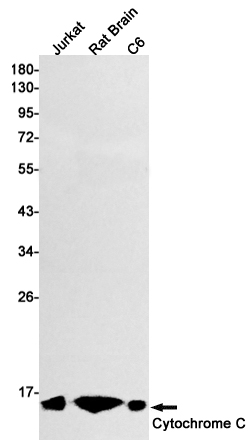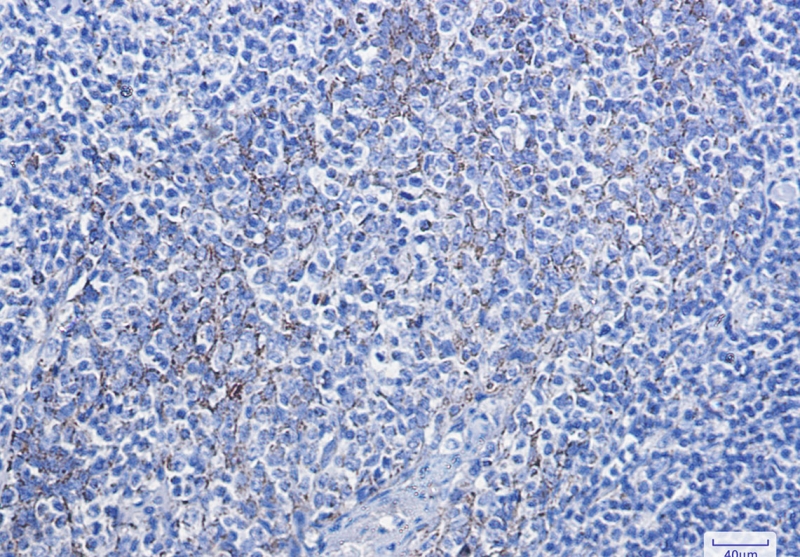


| WB | 1/500-1/1000 | Human,Mouse,Rat |
| IF | 1/20 | Human,Mouse,Rat |
| IHC | 1/50-1/100 | Human,Mouse,Rat |
| ICC | 技术咨询 | Human,Mouse,Rat |
| FCM | 咨询技术 | Human,Mouse,Rat |
| Elisa | 咨询技术 | Human,Mouse,Rat |
| Aliases | CYCS; CYC; Cytochrome c |
| Entrez GeneID | 54205 |
| WB Predicted band size | Calculated MW: 12 kDa; Observed MW: 12 kDa |
| Host/Isotype | Rabbit IgG |
| Antibody Type | Primary antibody |
| Storage | Store at 4°C short term. Aliquot and store at -20°C long term. Avoid freeze/thaw cycles. |
| Species Reactivity | Human,Mouse,Rat |
| Immunogen | A synthetic peptide of human Cytochrome C |
| Formulation | Purified antibody in TBS with 0.05% sodium azide,0.05%BSA and 50% glycerol. |
+ +
以下是3篇与Cytochrome C抗体相关的参考文献示例(注:内容为模拟概括,实际文献需通过数据库验证):
1. **文献名称**: "Release of Cytochrome C from Mitochondria During Apoptosis"
**作者**: Kluck, R.M. et al.
**摘要**: 该研究利用抗Cytochrome C抗体通过Western blot和免疫荧光技术,首次证实细胞凋亡过程中线粒体释放Cytochrome C至胞质,触发Caspase级联反应。
2. **文献名称**: "Cytochrome C Antibody-Based Detection of Neuronal Apoptosis in Alzheimer's Disease Models"
**作者**: Chen, Y. et al.
**摘要**: 文章采用特异性抗Cytochrome C抗体进行免疫组化分析,揭示阿尔茨海默病小鼠模型中神经元线粒体功能失调与Cytochrome C异常释放的相关性。
3. **文献名称**: "Immunoblotting Analysis of Cytochrome C in Myocardial Ischemia-Reperfusion Injury"
**作者**: Liu, X. et al.
**摘要**: 通过Western blot结合抗Cytochrome C抗体,验证心肌缺血再灌注损伤中线粒体通透性转换孔开放导致Cytochrome C释放,促进心肌细胞凋亡。
建议通过PubMed或Web of Science以关键词"Cytochrome C antibody"+"应用领域(如apoptosis/disease model)"检索最新文献。
Cytochrome C (Cyt C) is a small, evolutionarily conserved heme-containing protein located in the mitochondrial intermembrane space. It plays a dual role: as an essential component of the electron transport chain during aerobic respiration and as a key mediator of apoptosis. During programmed cell death, Cyt C is released from mitochondria into the cytosol, triggering caspase activation and cell degradation.
Antibodies targeting Cytochrome C are critical tools in biomedical research, widely used to detect its localization, expression, and release in various experimental models. These antibodies are typically generated in hosts like rabbits or mice using purified Cyt C or recombinant proteins as immunogens. Both monoclonal and polyclonal variants exist, offering options for specificity (monoclonal) or sensitivity (polyclonal) depending on experimental needs.
Applications include Western blotting, immunofluorescence, immunohistochemistry, and flow cytometry to study mitochondrial health, apoptosis pathways, and diseases like cancer or neurodegenerative disorders. Specific antibodies can distinguish between reduced (functional in respiration) and oxidized (apoptosis-associated) forms, aiding mechanistic studies. Quality validation often involves recombinant protein testing and knockout cell controls to confirm specificity. Cytochrome C antibodies thus serve as indispensable reagents for exploring cellular energetics, death signaling, and therapeutic interventions targeting mitochondrial dysfunction.
×